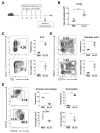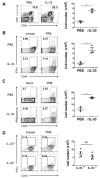Exogenous Interleukin-33 Contributes to Protective Immunity via Cytotoxic T-Cell Priming against Mucosal Influenza Viral Infection
- PMID: 31509992
- PMCID: PMC6783873
- DOI: 10.3390/v11090840
Exogenous Interleukin-33 Contributes to Protective Immunity via Cytotoxic T-Cell Priming against Mucosal Influenza Viral Infection
Abstract
Influenza is an infectious respiratory illness caused by the influenza virus. Though vaccines against influenza exist, they have limited efficacy. To additionally develop effective treatments, there is a need to study the mechanisms of host defenses from influenza viral infections. To date, the mechanism by which interleukin (IL)-33 modulates the antiviral immune response post-influenza infection is unclear. In this study, we demonstrate that exogenous IL-33 enhanced antiviral protection against influenza virus infection. Exogenous IL-33 induced the recruitment of dendritic cells, increased the secretion of pro-inflammatory cytokine IL-12, and promoted cytotoxic T-cell responses in the local microenvironment. Thus, our findings suggest a role of exogenous IL-33 in the antiviral immune response against influenza infection.
Keywords: IL-33; antiviral immunity; influenza virus.
Conflict of interest statement
The authors declare that the research was conducted in the absence of any commercial or financial relationships that could be construed as a potential conflict of interest.
Figures




Similar articles
-
CD47 Plays a Role as a Negative Regulator in Inducing Protective Immune Responses to Vaccination against Influenza Virus.J Virol. 2016 Jul 11;90(15):6746-6758. doi: 10.1128/JVI.00605-16. Print 2016 Aug 1. J Virol. 2016. PMID: 27194758 Free PMC article.
-
Vaccine molecules targeting Xcr1 on cross-presenting DCs induce protective CD8+ T-cell responses against influenza virus.Eur J Immunol. 2015 Feb;45(2):624-35. doi: 10.1002/eji.201445080. Epub 2014 Dec 28. Eur J Immunol. 2015. PMID: 25410055
-
Local IL-4 expression in the lung reduces pulmonary influenza-virus-specific secondary cytotoxic T cell responses.Virology. 2000 Mar 30;269(1):66-77. doi: 10.1006/viro.2000.0187. Virology. 2000. PMID: 10725199
-
Porcine innate and adaptative immune responses to influenza and coronavirus infections.Ann N Y Acad Sci. 2006 Oct;1081(1):130-6. doi: 10.1196/annals.1373.014. Ann N Y Acad Sci. 2006. PMID: 17135502 Free PMC article. Review.
-
Mouse Models Reveal Role of T-Cytotoxic and T-Reg Cells in Immune Response to Influenza: Implications for Vaccine Design.Viruses. 2019 Jan 11;11(1):52. doi: 10.3390/v11010052. Viruses. 2019. PMID: 30641955 Free PMC article. Review.
Cited by
-
Could Interleukin-33 (IL-33) Govern the Outcome of an Equine Influenza Virus Infection? Learning from Other Species.Viruses. 2021 Dec 15;13(12):2519. doi: 10.3390/v13122519. Viruses. 2021. PMID: 34960788 Free PMC article. Review.
-
IL-33 Induces an Antiviral Signature in Mast Cells but Enhances Their Permissiveness for Human Rhinovirus Infection.Viruses. 2022 Nov 1;14(11):2430. doi: 10.3390/v14112430. Viruses. 2022. PMID: 36366528 Free PMC article.
-
Lactobacillus plantarum Surface-Displayed ASFV (p14.5) Can Stimulate Immune Responses in Mice.Vaccines (Basel). 2022 Feb 24;10(3):355. doi: 10.3390/vaccines10030355. Vaccines (Basel). 2022. PMID: 35334986 Free PMC article.
-
Autophagy and the pancreas: Healthy and disease states.Front Cell Dev Biol. 2024 Sep 24;12:1460616. doi: 10.3389/fcell.2024.1460616. eCollection 2024. Front Cell Dev Biol. 2024. PMID: 39381372 Free PMC article. Review.
-
Host Protective Immune Responses against Influenza A Virus Infection.Viruses. 2020 May 3;12(5):504. doi: 10.3390/v12050504. Viruses. 2020. PMID: 32375274 Free PMC article. Review.
References
-
- Iuliano A.D., Roguski K.M., Chang H.H., Muscatello D.J., Palekar R., Tempia S., Cohen C., Gran J.M., Schanzer D., Cowling B.J., et al. Estimates of global seasonal influenza-associated respiratory mortality: A modelling study. Lancet. 2018;391:1285–1300. doi: 10.1016/S0140-6736(17)33293-2. - DOI - PMC - PubMed
Publication types
MeSH terms
Substances
LinkOut - more resources
Full Text Sources

